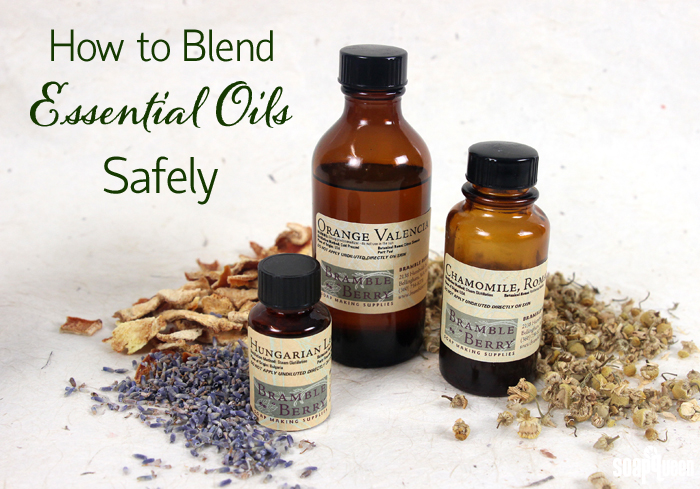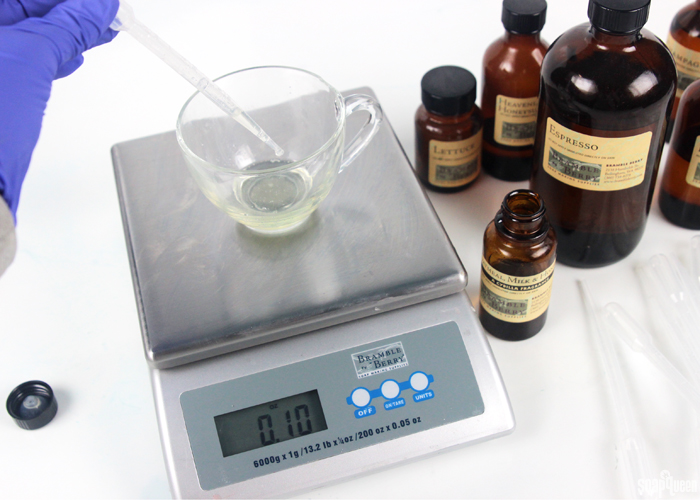
Essential oils are a great option for scenting your products naturally. Based on the definition from the International Organization for Standardization, essential oils are defined as “a product obtained from a natural raw material of plant origin, by steam distillation, by mechanical processes from the epicarp of citrus fruits, or by dry distillation, after separation of the aqueous phase — if any — by physical processes.” Click here to read this statement, which is included in their vocabulary of aromatic natural raw materials (ISO/D1S9235.2).
If you prefer to keep your products as natural as possible, essential oils are the way to go. Just like fragrance oils, it’s important to use them properly. Each essential oil has a different usage rate, and depending on what you’re making you’ll need to use a different amount. If too much essential oil is used in a product, it can cause skin irritation. The easiest way to find out how much essential oil is to use the Fragrance Calculator. Simply select what kind of product you’re making, how much you’re making and which essential oil you want to use. The Fragrance Calculator will then give you how much you can safely use in your product. For example, below you can see how much lemongrass essential oil is safe for 48 ounces of cold process soap.
One important note about the Fragrance Calculator: For fragrance oils, the calculator uses the usage rates recommended by IFRA (International Fragrance Association). For essential oils, there is no official IFRA usage rate. When calculating usage rates for essential oils, the Fragrance Calculator uses rates dependent on our tests and crafting experience. Just like most ingredients used in bath and beauty products, the usage rates may vary on personal preference. If you like to err on the side of caution, I recommend using the “light” suggested usage rate for essential oils. Then, I recommend making small test batch to make sure you enjoy the scent, and it does not irritate your skin.
But what about if you’re blending several essential oils into one product? How do you safely blend and use several essential oil in one recipe? I’ll share with you my favorite method to safely blend essential oils. I will preface by saying that everybody calculates their blends a little differently. If you use a different method, that’s okay – and, I’d love to hear how you do it. It’s all about personal preference, safety and what you’re comfortable with in your products.
For this example, let’s say we are using 10x orange essential oil, litsea essential oil and clove leaf essential oil in 48 ounces of cold process soap. If you’d also like to learn about blending fragrances, check out the Fragrance Oil Blending Tips post. While that blog post focuses on blending fragrance oils, the same tips and tricks also apply to essential oils.
 The fundamentals of blending fragrance and essential oils are very similar. Check out the Fragrance Oil Blending Tips post for more info.
The fundamentals of blending fragrance and essential oils are very similar. Check out the Fragrance Oil Blending Tips post for more info.
First, I always recommend doing a little bit of research about the properties of the essential oils you’re using. For example, clove leaf essential oil is a well-known skin irritant and skin sensitizer when applied directly to the skin. For this reason, I generally don’t recommend using it at all in leave-on products, like lotion. However, it is suitable for cold process soap, which is washed off. 10x orange essential oil is a photosensitizer, which means it can cause skin to become more sensitive to the sun when used in leave-on products. But because we are using it for cold process soap, no worries there. Litsea essential oil has no major skin concerns.
Once I know that each essential oil is suitable for my project, it’s time to blend. First, I like to find out the maximum usage rate for each oil for the total amount of soap. In this case, that is 48 ounces of cold process soap. Below are the Fragrance Calculator Results for each oil in my blend:
10x Orange Essential Oil Usage Rate for 48 ounces Cold Process Soap:
Clove Leaf Essential Oil Usage Rate for 48 ounces Cold Process Soap:
Litsea Essential Oil Usage Rate for 48 ounces Cold Process Soap:

As you can see, the maximum usage rate for listea and clove essential oil is 1.44 ounces. The maximum usage rate for 10x orange essential oil is 2.4 ounces. So, for this batch of soap, I don’t want to use more than 1.44 ounces of either the listea or clove essential oils in my blend. The total amount of essential oil that would be safe for this blend would be 2.4 ounces, which is the maximum usage rate for 10x orange essential oil. Once I decide how much clove and litsea I’d like to add to the blend, subtract that amount from 2.4 ounces.
Let’s say I want to use .5 ounces of clove leaf essential oil and 1 ounce of litsea, which equals 1.5 ounces. If my total blend can equal up to 2.4 ounces, that means I can add up to .9 ounces of 10X orange essential oil. If I want to use more orange essential oil, I need to decrease the amount of litsea or clove leaf. Using this method, I know that I will be using less than the maximum usage rate for each oil. If I were to use a 1:1:1 ratio, I would use .8 ounces of each oil which equals 2.4 ounces of essential oil total.
What if you want to use 1.2 ounces of litsea and 1.2 ounces of clove? Each of these amounts are below their max usage rate, but that equals 2.4 ounces which does not allow for any 10x orange essential oil in the blend. This is where a little bit of personal preference comes in. If you feel comfortable adding more orange essential oil to the blend, that is up to you but that is a lot of essential oil and way, way more than normal formulating rules would suggest.
Personally, I always like to be on the super safe side and use less rather than more. Everybody’s skin reacts to essential oils (and any other bath and beauty product) differently. If somebody is more sensitive, the max amount of the usage rate for all of the essential oils may not work well for their skin. After all, that is a lot of essential oil for one batch of soap! The Fragrance Calculator gives the International Fragrance Association (IFRA) suggested usage rates for fragrance oils, and my suggested usage rates for essential oils. I recommend staying within these guidelines, but doing your own tests to find out what amount of essential oil works best for you. A small test batch is really helpful. If you notice any skin irritation at all, you can reduce the essential oil amount for your next batch.
If you’re looking for more information on essential oils and how to safely use them in your products, check out the blog posts below!
The Truth About Vanilla Essential Oil
Undiluted Aroma Oils + Plastic Don’t Mix
Sunday Night Spotlight: Hungarian Lavender Essential Oil
Sunday Night Spotlight: Peppermint Essential Oil
Sunday Night Spotlight: Orange Essential Oil



